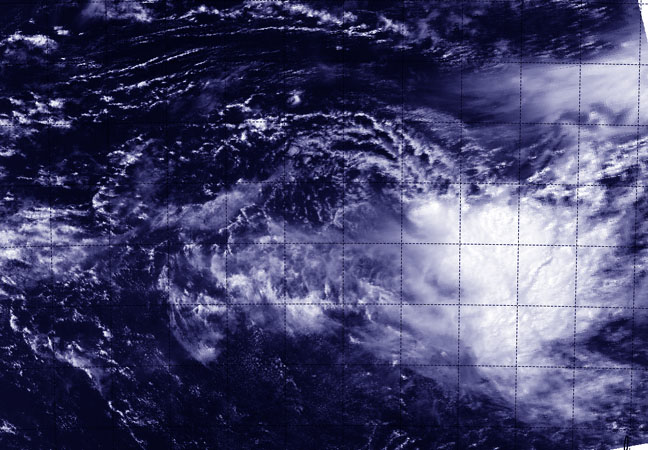NASA Sees Remnants of Tropical Cyclone Hadi in So. Pacific

NASA's Aqua satellite flew over Hadi's remnants on March 12 and the MODIS aboard captured a visible image that showed the strongest thunderstorms associated with the low appeared south of the center of circulation. Image Credit: NRL/NASA
When NASA's Aqua satellite flew over Hadi's remnants, the MODIS instrument aboard captured a visible image that showed the strongest thunderstorms associated with the low appeared south of the center of circulation.
The center was located near 15.1 south and 156.1 east, about 585 nautical miles/673.2 miles/ 1,083 km west of Vanuatu.
The Joint Typhoon Warning Center or JTWC noted that animated multispectral satellite imagery depicts an exposed, well-defined low-level circulation center with persistent deep convection over the southern semi-circle.
The Special Sensor Microwave Imager aboard the Defense Meteorological Satellite Program satellite showed that the low-level center of circulation is elongated, and there are shallow bands of thunderstorms over the southern quadrant.
The JTWC noted on March 12, “Based on the lack of convective structure, marginal environment and weak model development, the potential for the development of a significant tropical cyclone within the next 24 hours is downgraded to low.”
Text credit: Rob Gutro
NASA's Goddard Space Flight Center
Media Contact
All latest news from the category: Earth Sciences
Earth Sciences (also referred to as Geosciences), which deals with basic issues surrounding our planet, plays a vital role in the area of energy and raw materials supply.
Earth Sciences comprises subjects such as geology, geography, geological informatics, paleontology, mineralogy, petrography, crystallography, geophysics, geodesy, glaciology, cartography, photogrammetry, meteorology and seismology, early-warning systems, earthquake research and polar research.
Newest articles

Superradiant atoms could push the boundaries of how precisely time can be measured
Superradiant atoms can help us measure time more precisely than ever. In a new study, researchers from the University of Copenhagen present a new method for measuring the time interval,…

Ion thermoelectric conversion devices for near room temperature
The electrode sheet of the thermoelectric device consists of ionic hydrogel, which is sandwiched between the electrodes to form, and the Prussian blue on the electrode undergoes a redox reaction…

Zap Energy achieves 37-million-degree temperatures in a compact device
New publication reports record electron temperatures for a small-scale, sheared-flow-stabilized Z-pinch fusion device. In the nine decades since humans first produced fusion reactions, only a few fusion technologies have demonstrated…





















